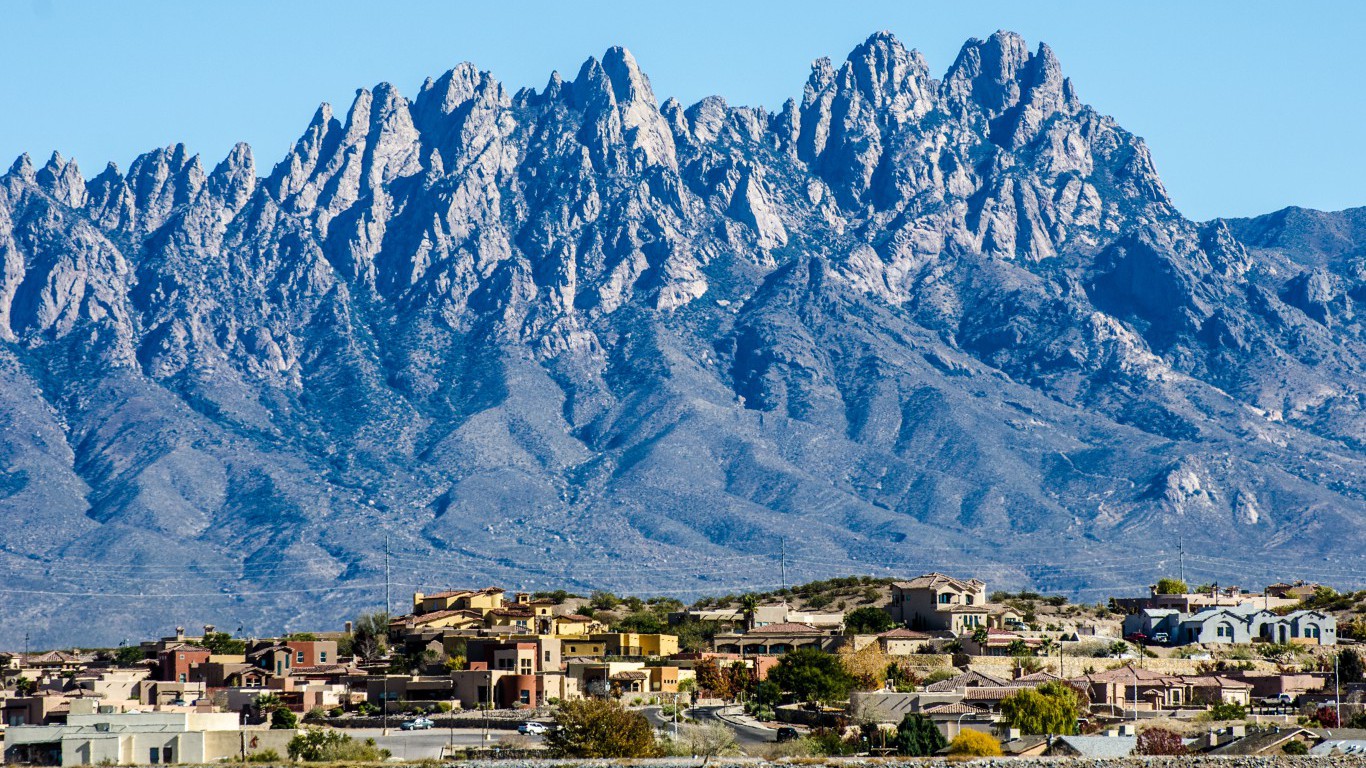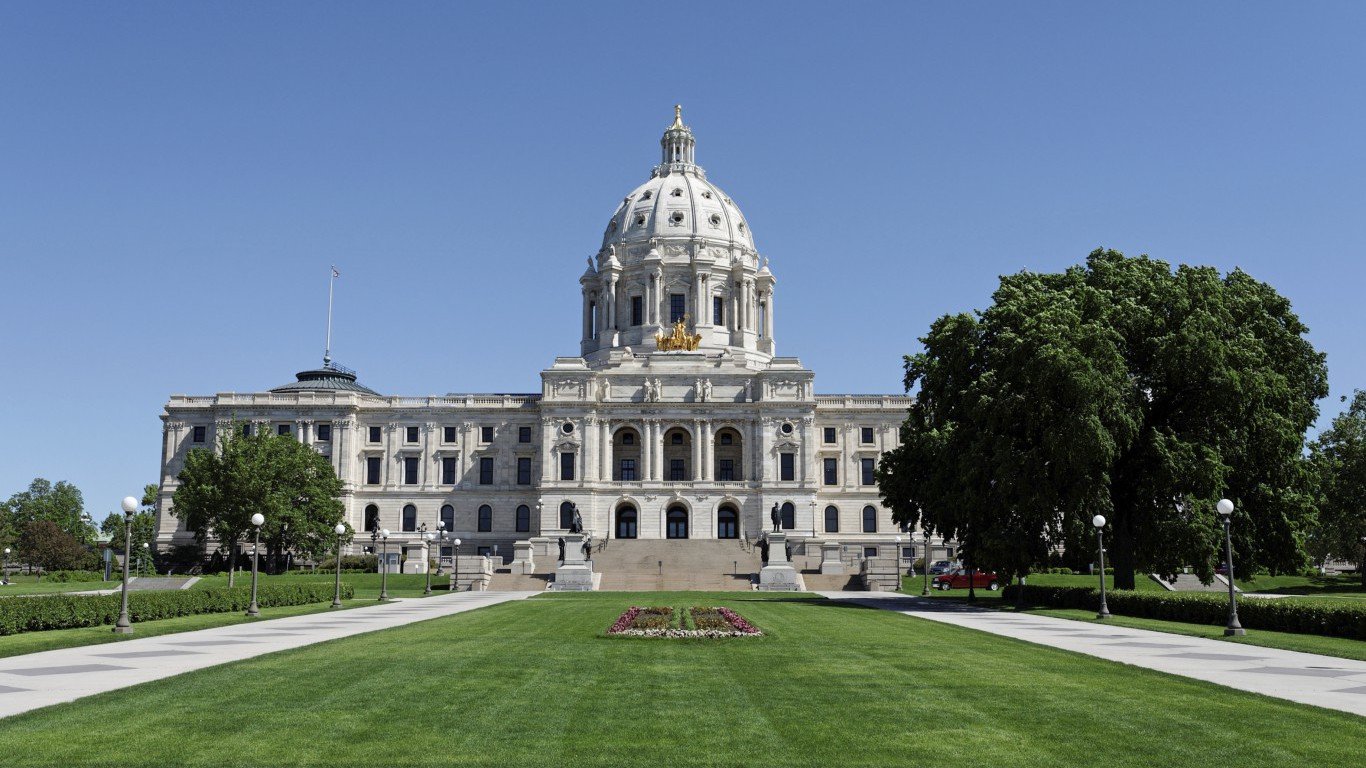

Excessive drinking can lead to a variety of health problems and significantly shorten a person’s life. The habit claims nearly 90,000 lives each year, according to the Centers for Disease Control and Prevention. And those who die as the result of alcohol abuse do so 30 years prematurely, on average.
Excessive alcohol consumption, according to the CDC, includes binge drinking and heavy drinking. Binge drinking is defined as four or more drinks in a single occasion for women and five or more for men, and heavy drinking is defined as at least eight drinks per week for women and 15 for men.
Nationwide, 18.0% of American adults drink an excessive amount of alcohol. However, the excessive drinking rate ranges considerably across states. In some states, just over 1 in 10 adults drink too much on a regular basis, while in others, the share is closer to 1 in 4.
24/7 Wall St. reviewed data from the CDC to identify the states reporting the highest levels of adults who binge drink or drink heavily.
Click here to see America’s drunkest states.
Click here to read our detailed findings methodology.

50. Tennessee
> Adults drinking excessively: 11.2%
> Alcohol-related driving deaths: 28.0% (11th lowest)
> Adults in fair or poor health: 19.9% (9th highest)
> Drunkest metro area: Nashville-Davidson–Murfreesboro–Franklin
Binge or heavy drinking is less of a problem in Tennessee than in any other state. However, it is not a rarity either as 11.2% of the adult population drinks excessively. Nationwide, a much higher percentage of adults report excessive drinking, at 18.0%.
Excessive drinking over time can lead to a myriad serious and potentially fatal health issues, including certain cancers, high blood pressure, and cardiovascular disease. Despite the relatively few adults who binge drink or drink heavily, Tennessee has one of the highest premature death rates of any state. For every 100,000 state residents, 436 die before age 75, the eighth highest premature death rate among states. Perhaps the adult smoking rate of 21.9% — the seventh highest share among all states — contributes to the higher premature death rate.
[in-text-ad]

49. West Virginia
> Adults drinking excessively: 11.4%
> Alcohol-related driving deaths: 32.0% (25th lowest)
> Adults in fair or poor health: 23.7% (the highest)
> Drunkest metro area: Morgantown, WV
Only 11.4% of adults binge or heavily drink in West Virginia, much less than the 18.0% of adults who binge or heavily drink nationwide. States with lower excessive drinking rates are often home to lower income populations; and West Virginia is no exception. The state’s median household income of $43,385 is well below the median household income nationwide of $57,617, and the second lowest of any state.
Alcohol consumption is just one of many behavioral factors that can affect health outcomes and as a result, areas with low excessive drinking rates are not necessarily the healthiest. In West Virginia, nearly 24% of adults are in fair or poor health, the largest share of any state.

48. Utah
> Adults drinking excessively: 12.4%
> Alcohol-related driving deaths: 19.7% (the lowest)
> Adults in fair or poor health: 12.9% (6th lowest)
> Drunkest metro area: Salt Lake City, UT
In Utah, 12.4% of adults report excessive drinking, well below the 18.0% share of adults nationwide who either binge drink or drink heavily. States with a lower share of adults drinking excessively tend to have lower rates of alcohol-related driving deaths. Only 19.7% of driving deaths in Utah involve alcohol, the lowest alcohol-related driving death rate of any state and far below nationwide rate of 30.0%.
Low excessive drinking rates in Utah are partially attributable to religious faith. Over half of the state’s population identify as Mormon, a religion that expressly forbids alcohol consumption.

47. Alabama
> Adults drinking excessively: 13.0%
> Alcohol-related driving deaths: 29.4% (17th lowest)
> Adults in fair or poor health: 21.2% (4th highest)
> Drunkest metro area: Auburn-Opelika, AL
In Alabama, 13.0% of adults drink to excess on a regular basis. This is a considerably lower share than the 18.0% of adults who binge or drink heavily nationwide. Although excessive drinking can lead to serious health problems, including liver cancer and cardiovascular disease, states with lower shares of adults drinking excessively are often less healthy than states reporting higher shares of excessive drinking. An estimated 21.2% of adults in Alabama are in fair or poor health, the fourth largest share of any state.
Alcohol consumption is only one factor that can affect health. While Alabama adults drink less, many struggle with other health issues. For example, an estimated 34.0% of adults are obese, the fifth highest share among states.
[in-text-ad-2]

46. Mississippi
> Adults drinking excessively: 13.3%
> Alcohol-related driving deaths: 23.3% (3rd lowest)
> Adults in fair or poor health: 22.2% (3rd highest)
> Drunkest metro area: Gulfport-Biloxi-Pascagoula, MS
Just 13.3% of adults in this Southern state binge or heavily drink, much less than the comparable national share of 18.0%. Despite the link between excessive drinking and a myriad of health problems, states with lower drinking rates tend to report worse health outcomes than states with higher drinking rates. In Mississippi, 22.2% of adults report being in fair or poor health — the third largest share of any state. This could be a function of income, as states with lower drinking rates also tend to have lower incomes, and poorer states generally report poorer health outcomes. Mississippi has the lowest median household income of all states at $41,754 a year and the highest poverty rate at 20.8%.
While excessive drinking is never healthy, it is only one behavioral factor that can affect health. For example, lack of exercise can lead to obesity and heart problems, and in Mississippi, 31.9% of adults lead completely sedentary lives, the highest share among all states and well above the national average of 22.0%.

45. New Mexico
> Adults drinking excessively: 13.8%
> Alcohol-related driving deaths: 32.1% (25th highest)
> Adults in fair or poor health: 20.2% (8th highest)
> Drunkest metro area: Santa Fe, NM
Some 13.8% of adults in New Mexico binge drink or drink heavily, a smaller share than the 18.0% of American adults who do. Despite the lower excessive drinking rate, the state reports poorer health outcomes such as an above average premature death rate and a higher share of adults reporting being in fair or poor health.
In general, states that have smaller shares of adults who drink heavily are likely to have lower incomes. New Mexico is one such example with a median household income of $46,748 a year, nearly $11,000 below the national figure of $57,617 and the seventh lowest median income nationwide. New Mexico also has the third highest poverty among all states at 19.8%.
[in-text-ad]

44. Oklahoma
> Adults drinking excessively: 13.9%
> Alcohol-related driving deaths: 29.9% (19th lowest)
> Adults in fair or poor health: 20.9% (6th highest)
> Drunkest metro area: Lawton, OK
Nearly 14% of adults in Oklahoma drink excessively — below the national average of 18.0%. Over time, binge or heavy drinking can lead to many health problems. However, excessive drinking is only one of many factors that can contribute to poor health. Adults in Oklahoma are much more likely to be physically inactive and smoke than the typical American. Partially as a result, despite a lower binge and heavy drinking rate, about 1 in 4 adults in the state are in fair or poor health, the sixth highest share of any state.

43. North Carolina
> Adults drinking excessively: 14.9%
> Alcohol-related driving deaths: 32.3% (24th highest)
> Adults in fair or poor health: 18.5% (12th highest)
> Drunkest metro area: Jacksonville, NC
Nationwide, 18.0% of adults drink excessively. In North Carolina, that share is much lower at 14.9%. Drinking too much alcohol on a regular basis can lead to many health complications — both short and long term — ranging from alcohol poisoning to certain cancers. Despite the lower percentage of adults drinking to excess, 18.5% of adults in North Carolina report being in poor or fair health, the 12th highest share of any state and well above the national average of 15.0%. One possible explanation for poorer health outcomes in North Carolina may be above average physical inactivity and obesity rates at 24.0% and 29.7%, respectively. Nationwide, 22.0% of adults get no exercise beyond getting up and going to work and 28.0% of adults are obese.

42. Arkansas
> Adults drinking excessively: 15.3%
> Alcohol-related driving deaths: 28.4% (13th lowest)
> Adults in fair or poor health: 22.7% (2nd highest)
> Drunkest metro area: Fayetteville-Springdale-Rogers, AR-MO
Some 15.3% of adults in Arkansas drink to excess, which is below the national average of 18.0%. States where binge drinking and drinking heavily are less common tend to have poorer health outcomes, despite the many negative health problems associated with excessive alcohol consumption. Drinking alcohol is an expensive unhealthy habit and tends to be less common in states with lower incomes — which often report worse health outcomes than wealthier states.
Arkansas is no different. The state’s median annual household income of $44,334 is well below the national figure of $57,617. Some 22.7% of adults in the state report being in fair or poor health, the second largest share among all states.
[in-text-ad-2]

41. Idaho
> Adults drinking excessively: 15.4%
> Alcohol-related driving deaths: 32.4% (23rd highest)
> Adults in fair or poor health: 14.1% (14th lowest)
> Drunkest metro area: Coeur d’Alene, ID
Only 15.4% of adults in Idaho drink excessively, a smaller share than the 18.0% of adults nationwide. Excessive drinking is never healthy and Idaho’s low excessive drinking rate partially explains some positive health outcomes. A key measure of health is the premature death rate, and Idaho’s is below average. For every 100,000 state residents, 310 die before the age of 75. Nationwide, there are 333 deaths before age 75 for every 100,000 people.
According to the CDC, excessive alcohol consumption can lead to risky sexual behavior — and Idaho’s low excessive drinking rate may partially explain a low incidence of sexually transmitted diseases. There are 337 diagnosis of chlamydia per 100,000 state residents annually, one the lowest such rates among states and well below the U.S. rate of 456 per 100,000.

40. Maryland
> Adults drinking excessively: 15.5%
> Alcohol-related driving deaths: 32.8% (20th highest)
> Adults in fair or poor health: 13.3% (8th lowest)
> Drunkest metro area: California-Lexington Park, MD
Some 15.5% of adults in Maryland binge drink or drink heavily, which is less than the national share of American adults who drink in excess at 18.0%. According to the CDC, excessive alcohol consumption can lead to depression and anxiety — and Maryland’s low excessive drinking rate may help explain better than average mental health outcomes. Adults in the state report an average of just 3.4 mentally unhealthy days per month, fewer than the 3.7 day national average.
States with smaller shares of adults who drink excessively tend to have lower median household incomes. Maryland, however, is the exception. The median annual household income in the state of $78,945 is the highest of any state and over $20,000 above the national median of $57,617.
[in-text-ad]

39. Nevada
> Adults drinking excessively: 15.8%
> Alcohol-related driving deaths: 32.8% (21st highest)
> Adults in fair or poor health: 17.2% (17th highest)
> Drunkest metro area: Reno, NV
Nationwide, 18.0% of adults drink to excess, whereas in Nevada, only 15.8% of adults binge drink or drink heavily. Drinking large quantities of alcohol can lead to many health issues, yet states with lower shares of adults drinking excessively tend to be less healthy than those with higher shares. For example, the premature death rate is higher in Nevada than in most states — likely due to several factors other than alcohol consumption. For every 100,000 people in Nevada, 360 die before the age of 75.

38. Arizona
> Adults drinking excessively: 16.0%
> Alcohol-related driving deaths: 27.6% (9th lowest)
> Adults in fair or poor health: 18.5% (11th highest)
> Drunkest metro area: Flagstaff, AZ
Binge drinking or drinking heavily are not healthy habits. Despite this, states with a lower portion of adults who drink in excess tend to report poorer health outcomes than those with larger portions of adults who drink excessively. In Arizona, 16.0% of adults engage in binge drinking or drinking heavily, less than the national average of 18.0%. Despite the lower excessive drinking rate, 18.5% of adults in the state report they are in fair or poor health, the 11th highest share of any state.

37. Kentucky
> Adults drinking excessively: 16.3%
> Alcohol-related driving deaths: 28.5% (14th lowest)
> Adults in fair or poor health: 20.9% (7th highest)
> Drunkest metro area: Louisville/Jefferson County, KY-IN
Some 16.3% of Kentucky adults drink to excess, which is less than the comparable national share of 18.0%. Excessive drinking can lead to a slew of health conditions such as hypertension and liver disease. However, states with lower shares of adults who binge drink or drink heavily are typically less healthy than those with higher shares of adults who drink excessively. In Kentucky, nearly 21% of adults report they are in fair or poor health, the seventh highest share of all states. This could be because many of the states that report lower excessive drinking rates have lower incomes — and states with lower incomes and higher poverty rates tend to report less healthful behavior and worse health outcomes than wealthier states.
This appears to be the case in Kentucky, which is one of the poorest states in the country. The state reports 25.9% smoking rate among adults, the highest of any state. Also, 32.9% of state adults are obese, which is well above the national obesity rate of 28.0%.
[in-text-ad-2]

36. South Carolina
> Adults drinking excessively: 16.6%
> Alcohol-related driving deaths: 37.8% (7th highest)
> Adults in fair or poor health: 17.0% (19th highest)
> Drunkest metro area: Hilton Head Island-Bluffton-Beaufort, SC
Some 16.6% of adults in South Carolina binge drink or drink heavily, which is below the 18.0% share of American adults who drink to excess. States with low incomes and high poverty rates tend to report worse health outcomes than wealthier states, and this is the case in South Carolina. The median income of households in the state is $49,501 a year, which is well below the nationwide median household income of $57,617. The poverty rate in South Carolina is 15.3%, one of the higher state poverty rates.
While drinking too much alcohol is unhealthy, it is only one factor that can cause adverse health effects. Obesity and smoking are some of the other factors. In South Carolina, 31.8% of adults are obese — the ninth highest share of any state — and the smoking rate is higher than the national average.

35. Delaware
> Adults drinking excessively: 16.6%
> Alcohol-related driving deaths: 37.9% (6th highest)
> Adults in fair or poor health: 16.7% (21st highest)
> Drunkest metro area: Dover, DE
Tied with South Carolina, some 16.6% of adults in Delaware binge drink or drink heavily, which is less than the share of American adults who drink to excess at 18.0%. Typically, states where the excessive drinking rate is lower also have lower shares of deaths from alcohol-involved car crashes. Despite a lower share of adults who drink excessively, 37.9% of all deaths from car crashes in South Carolina are related to alcohol consumption, the sixth highest share of any state.
[in-text-ad]

34. Indiana
> Adults drinking excessively: 16.8%
> Alcohol-related driving deaths: 23.6% (5th lowest)
> Adults in fair or poor health: 18.0% (14th highest)
> Drunkest metro area: Bloomington, IN
A total of 16.8% of Indiana adults drink to excess, less than the national excessive drinking rate of 18.0%. Binge or heavy drinking can lead to many health issues, including high blood pressure, stroke, and long-term memory problems. Like many states reporting lower excessive drinking rates, incomes are lower in Indiana. The median household income of $52,314 a year, below the national median household income of $57,617.
Despite the relatively low excessive drinking rate in Indiana, the premature death rate in the state of 387 deaths before the age of 75 for every 100,000 people is the 10th highest. This is likely — at least in part — the result of the high obesity rate in the state, which at 31.7% is also the 10th highest of all states. Earning a low income makes it challenging to afford healthful food and and exercise opportunities, and the state’s low income helps explain its high obesity rate.

33. Georgia
> Adults drinking excessively: 16.8%
> Alcohol-related driving deaths: 23.4% (4th lowest)
> Adults in fair or poor health: 17.5% (16th highest)
> Drunkest metro area: Athens-Clarke County, GA
Similar to Indiana, some 16.8% of adults in Georgia drink excessively. Nationwide, 18.0% of adults binge drink or drink heavily. Excessive drinking over time can lead to myriad health issues, both mentally and physically, including depression and cardiovascular disease. Despite the lower share of adults who drink to excess, Georgia has a relatively high premature death rate. An estimated 377 of every 100,000 people die before the age of 75 in Georgia. Excess consumption of alcohol is only one factor that can contribute to poor health — obesity can also cause serious health complications. The adult obesity rate in Georgia of 29.6% above the national rate of 28.0%.

32. Kansas
> Adults drinking excessively: 16.9%
> Alcohol-related driving deaths: 27.3% (8th lowest)
> Adults in fair or poor health: 15.1% (22nd lowest)
> Drunkest metro area: Lawrence, KS
In this Midwestern state, 16.9% of the adult population drinks alcohol to excess — a lower percentage than the the national rate of 18.0%. Excessive drinking of alcohol can lead to a variety of health issues, including, but not limited to, breast, liver, and colon cancer. Despite the lower drinking rate, Kansas does not report the best health outcomes. For example, 30.8% of adult residents are obese, likely partially due to the fact that 23.5% of adults lead sedentary lives. Both the obesity and physical inactivity rates are above the comparable national rates of 28.0% and 22.0%, respectively.
[in-text-ad-2]

31. Texas
> Adults drinking excessively: 17.3%
> Alcohol-related driving deaths: 29.9% (18th lowest)
> Adults in fair or poor health: 19.3% (10th highest)
> Drunkest metro area: Austin-Round Rock, TX
Some 17.3% of adult residents in Texas report either drinking heavily or binge drinking, less than the 18.0% of American adults who drink excessively. Despite a lower heavy drinking rate, 19.3% of adults in Texas report they are in fair or poor health, which is the 10th highest share among all 50 states. It is likely that the high percentage of adults who are physically inactive in the state contributes to its poor health outcomes. Some 23.0% of adults in Texas lead sedentary lifestyles, higher than the national average inactivity rate.

30. Virginia
> Adults drinking excessively: 17.4%
> Alcohol-related driving deaths: 30.5% (20th lowest)
> Adults in fair or poor health: 14.6% (20th lowest)
> Drunkest metro area: Blacksburg-Christiansburg-Radford, VA
The national share of adults who drink excessive amounts of alcohol is 18.0%. In Virginia, 17.4% of adults report drinking to excess. States with lower portions of adults binge drinking or drinking heavily tend to report less healthy outcomes. That is likely because many of these states are generally poorer — and low income states tend to report worse health than wealthier states. The opposite is true for Virginia, however. The state’s median household income of $68,114 a year is well above the national median, and the poverty rate is just 11.0%. The nationwide poverty rate is 14.0%.
Partially due to the state’s higher incomes, Virginia adults tend to be quite healthy, reporting below-average obesity, smoking, and premature death rates.
[in-text-ad]

29. Florida
> Adults drinking excessively: 17.4%
> Alcohol-related driving deaths: 28.2% (12th lowest)
> Adults in fair or poor health: 17.1% (18th highest)
> Drunkest metro area: Crestview-Fort Walton Beach-Destin, FL
Similar to Virginia, 17.4% of adults in Florida also drink excessively. Typically, states with below average shares of adults who binge drink or drink heavily have lower incomes and higher poverty rates. In Florida, the median household income of $50,860 a year is about $6,800 less than the national figure. Those with lower incomes often lack access to luxuries including alcohol and healthy foods. A diet that lacks a diversity of nutritious foods can result in poor health outcomes, which helps explain why 17.1% of adults in Florida report they are in fair or poor health. For perspective, only 15.0% of American adults report they are in fair or poor health.

28. Wyoming
> Adults drinking excessively: 17.5%
> Alcohol-related driving deaths: 35.3% (10th highest)
> Adults in fair or poor health: 14.4% (19th lowest)
> Drunkest metro area: Casper, WY
In Wyoming, a reported 17.5% of adults drink to excess, less than the comparable national share of 18.0%. Despite a lower frequency of adults drinking heavily, 35.3% of deaths from car crashes involve alcohol, the 10th highest share of any state. This factor, along with a higher smoking rate, may contribute to the above average premature death rate in Wyoming. Some 347 people die before age 75 for every 100,000 people in Wyoming, which is higher than the nationwide rate of about 333 premature deaths per every 100,000 Americans.

27. New Jersey
> Adults drinking excessively: 17.6%
> Alcohol-related driving deaths: 24.3% (6th lowest)
> Adults in fair or poor health: 15.2% (23rd lowest)
> Drunkest metro area: Ocean City, NJ
Some 17.6% of adults in New Jersey drink excessively, slightly less than the national average of 18.0%. States with lower shares of adults who are excessive drinkers tend to have lower incomes and report worse health outcomes. This is not the case for New Jersey, which is one of the wealthier states. The median household income in the state of $76,126 a year is the third highest income among all states. Likely because those with higher incomes are able to afford better access to health care and healthy lifestyles, New Jersey reports some of the better health outcomes nationwide. The state’s obesity, smoking, and premature death rates are lower than the comparable national rates.
[in-text-ad-2]

26. Missouri
> Adults drinking excessively: 17.7%
> Alcohol-related driving deaths: 31.7% (23rd lowest)
> Adults in fair or poor health: 16.6% (22nd highest)
> Drunkest metro area: Columbia, MO
A total of 17.7% of adults in Missouri drink to excess, slightly less than the 18.0% of American adults who binge drink or drink heavily. States with below average shares of adults who drink to excess typically have lower incomes. In Missouri, the median household income of $51,746 each year is below the national income of $57,617.

25. South Dakota
> Adults drinking excessively: 17.7%
> Alcohol-related driving deaths: 35.2% (11th highest)
> Adults in fair or poor health: 12.8% (5th lowest)
> Drunkest metro area: Sioux Falls, SD
The rate of adults drinking excessively in South Dakota is 17.7%, slightly less than the national share of 18.0%. Lower excessive drinking rates tend to reflect worse health outcomes, and as might be expected in a state with average excessive drinking, South Dakota’s health outcomes appear in line with the national average as well. Out of every 100,000 state residents, 323 die before the age of 75, just slightly below the national rate of 333 per 100,000.
[in-text-ad]

24. Washington
> Adults drinking excessively: 17.8%
> Alcohol-related driving deaths: 35.0% (12th highest)
> Adults in fair or poor health: 14.3% (18th lowest)
> Drunkest metro area: Seattle-Tacoma-Bellevue, WA
Some 17.8% of adults in Washington state drink excessively, slightly less than the comparable national share of 18.0%. States with lower shares of adults who are excessive drinkers tend to have lower incomes, and the opposite tend to be true in states where heavy drinking is more common. In Washington, the median household income is $67,106, somewhat higher than the national figure of $57,617.

23. Rhode Island
> Adults drinking excessively: 17.9%
> Alcohol-related driving deaths: 40.4% (3rd highest)
> Adults in fair or poor health: 15.8% (24th highest)
> Drunkest metro area: Providence-Warwick, RI-MA
A total of 17.9% of adults in Rhode Island drink to excess — just below the national share of adults binge drinking or drinking heavily at 18.0%. States where adults drink at near the national rate also tend to have to report alcohol-related driving deaths similar to the country as a whole. In Rhode Island, however, some 40.4% of driving deaths were due to alcohol, the third highest alcohol-related driving death rate of any state and well above the national rate of 30.0%.

22. California
> Adults drinking excessively: 18.0%
> Alcohol-related driving deaths: 29.0% (15th lowest)
> Adults in fair or poor health: 17.8% (15th highest)
> Drunkest metro area: Chico, CA
Some 18.0% of adults in California drink excessively, equivalent to the national excessive drinking rate. Wealthier states tend to report better health outcomes, likely because of better health care access and the ability to afford healthier lifestyles. In California, the median household income of $67,739 a year is nearly $10,000 greater than the national income of $57,617 and one of the wealthiest states in America.
Despite higher rates of drinking excessively, adults in California are some of the healthiest in all the country. Only 22.7% of adults are obese, the third lowest share among all states and well below the national obesity rate of 28.0%. In addition, only 11.7% of adults smoke, the second lowest share nationwide. Both low obesity and smoking rates may have positively contributed to the state’s low premature death rate. At 468 deaths before age 75 for every 100,000 state residents, it is the third lowest premature death rate of any state.
[in-text-ad-2]

21. Pennsylvania
> Adults drinking excessively: 18.1%
> Alcohol-related driving deaths: 32.0% (24th lowest)
> Adults in fair or poor health: 15.3% (25th lowest)
> Drunkest metro area: State College, PA
An estimated 18.1% of adults in Pennsylvania drink excessively, which slightly surpasses the national rate of 18.0%. Excessive drinking can lead to several serious health issues including cardiovascular disease and liver cancer. In Pennsylvania, where the excessive drinking rate is just slightly higher than the national rate, the premature death rate is also just slightly higher. For every 100,000 Pennsylvania residents, about 342 die before the age of 75, slightly more than the nationwide rate of 333 premature deaths per every 100,000.

20. New York
> Adults drinking excessively: 18.2%
> Alcohol-related driving deaths: 23.0% (2nd lowest)
> Adults in fair or poor health: 16.2% (23rd highest)
> Drunkest metro area: Watertown-Fort Drum, NY
At 18.2%, New York’s excessive drinking rate is roughly in line with that of the national share of 18.0%. Despite the fact that a slightly larger share of adults drink heavily or binge drink, driving deaths attributable to alcohol are rare compared to most states. Only 23.0% of all roadway fatalities involve alcohol, the second lowest share among any state and well below the national rate of 30.0%.
[in-text-ad]

19. New Hampshire
> Adults drinking excessively: 18.4%
> Alcohol-related driving deaths: 31.2% (22nd lowest)
> Adults in fair or poor health: 11.5% (2nd lowest)
> Drunkest metro area: Manchester-Nashua, NH
New Hampshire’s excessive drinking rate of 18.4% is slightly higher than the national figure of 18.0%. Despite a slightly above average excessive drinking rate, a strong majority of adults in New Hampshire report they are in good health. Only 11.5% report being in fair or poor health — the second lowest share of any state. The premature death rate is also quite low in New Hampshire, with 290 deaths before the age of 75, per every 100,000 residents, also one of the lowest shares among the states. With smoking being one of the leading causes of premature death, it is possible that the low smoking rate of just 15.9% — well below the national smoking rate of 18.0% — contributes to the lower premature death rate and better health outcomes overall.

18. Connecticut
> Adults drinking excessively: 18.6%
> Alcohol-related driving deaths: 33.4% (18th highest)
> Adults in fair or poor health: 14.3% (17th lowest)
> Drunkest metro area: Bridgeport-Stamford-Norwalk, CT
Alcohol is not cheap, and wealthy individuals are more likely than lower-income individuals to be able to afford drinking on a regular basis. Connecticut is one of the wealthier states with a median household income of $73,433 a year, which greatly exceeds the comparable national income of $57,617. Some 18.6% of adults in the state binge or heavily drink, more than the comparable national share of 18.0%.
Despite the fact that excessive drinking is a common habit in the state, adults in Connecticut tend to report healthy outcomes. Of all adults in the state, about 1 in 4 are obese, one of the lowest obesity rates among all states and well below the national rate of 28.0%. In addition, only 13.5% of adults reportedly smoke, the third lowest rate of any state.

17. Louisiana
> Adults drinking excessively: 18.8%
> Alcohol-related driving deaths: 32.6% (22nd highest)
> Adults in fair or poor health: 21.0% (5th highest)
> Drunkest metro area: Houma-Thibodaux, LA
Some 18.8% of adults in Louisiana drink excessively, more than the 18.0% of adults who drink to excess nationwide. States with higher excessive drinking rates tend to be wealthier, at least in part because alcohol can be costly. In Louisiana, however, the median household income of $45,156 a year is well below the comparable national income of $57,617. The poverty rate in Louisiana is also incredibly high. At 20.2%, it is the second highest poverty rate among states and well above the the national rate of 14.0%.
Binge or heavy drinking can lead to a slew of health issues such as hypertension and cancer. Perhaps the high drinking rate in Louisiana contributes to the high premature death rate. For every 100,000 residents, 452 die before age 75, the sixth highest share among the states.
[in-text-ad-2]

16. Oregon
> Adults drinking excessively: 18.8%
> Alcohol-related driving deaths: 32.8% (19th highest)
> Adults in fair or poor health: 18.3% (13th highest)
> Drunkest metro area: Portland-Vancouver-Hillsboro, OR-WA
Some 18.8% of adults in Oregon binge or heavily drink, more than the national share of 18.0%. States with higher drinking rates tend to report better health outcomes, likely because they are also higher-income states. In Oregon, however, adults report relatively good health outcomes, despite both an average drinking rate and a median household income that is close to the national figure.
For example, only 15.3% of adults lead sedentary lives, the second lowest share among states and well below the national rate of 22.0%. The high rate of adults in Oregon who routinely engage in physical activity has likely contributed to the state’s low obesity rate. Only 26.4% of adults are obese in Oregon — below the nationwide obesity rate of 28.0%.

15. Colorado
> Adults drinking excessively: 19.1%
> Alcohol-related driving deaths: 34.7% (13th highest)
> Adults in fair or poor health: 13.7% (11th lowest)
> Drunkest metro area: Fort Collins, CO
An estimated 19.1% of adults in Colorado drink excessively, a larger share than in most states and more than the 18.0% excessive drinking rate nationwide. Despite a greater likelihood of alcohol abuse, adults in Colorado are healthier than most Americans by other important measures. For example, just 14.4% of adults in the state lead sedentary lives, the smallest share of any state and well below the 22.0% physical inactivity rate nationwide. Active lifestyles partly explain some healthy outcomes in Colorado. Just 20.2% of the state’s adult population are obese, the smallest share of any state.
[in-text-ad]

14. Ohio
> Adults drinking excessively: 19.2%
> Alcohol-related driving deaths: 34.3% (14th highest)
> Adults in fair or poor health: 15.3% (24th lowest)
> Drunkest metro area: Columbus, OH
Some 19.2% of adults drink excessively in Ohio, more than the comparable national share of 18.0%. Binge drinking and heavy drinking are not healthy behaviors and can lead to a slew of health complications and disease, including stroke and cardiovascular disease. Such serious ailments can shorten life. In Ohio, the premature death rate is higher than in most states and above the national average. For every 100,000 residents, an estimated 382 die before the age of 75, the 12th highest share of any state.
Excessive drinking is just one factor that impacts health negatively. Ohio adults also report above average obesity and smoking rates at 31.4% and 21.6%, respectively.

13. Massachusetts
> Adults drinking excessively: 19.5%
> Alcohol-related driving deaths: 27.8% (10th lowest)
> Adults in fair or poor health: 14.2% (15th lowest)
> Drunkest metro area: Barnstable Town, MA
Nearly 1 in 5 adults living in Massachusetts drink excessively, a larger share than in the majority of states. Aside from a greater tendency to engage in binge drinking or heavy drinking, Massachusetts residents tend to be relatively healthy. For example, just 14.0% of the adult population smokes, well below the 18.0% national adult smoking rate. Additionally, just 20.3% of adults in the state get no exercise beyond getting up and going to work, a lower physical inactivity rate than the comparable 22.0% U.S. share.

12. Vermont
> Adults drinking excessively: 19.6%
> Alcohol-related driving deaths: 33.4% (17th highest)
> Adults in fair or poor health: 11.4% (the lowest)
> Drunkest metro area: Burlington-South Burlington, VT
The excessive drinking rate in of 19.6% in Vermont is one of the highest in the nation and higher than the national average of 18.0%. Despite the higher excessive drinking rate, a strong majority of adults report they are in good health. Only 11.4% report poor health, the lowest share of any state.
Exercise is an important determinant of good health, and 81.5% of Vermont adults are physically active — more than in most states and above the national average of 78.0%. The high physical activity rate may have contributed to the low obesity rate of 24.4%, the sixth lowest of any state and well below the national obesity rate at 28.0%.
[in-text-ad-2]

11. Maine
> Adults drinking excessively: 19.6%
> Alcohol-related driving deaths: 39.8% (4th highest)
> Adults in fair or poor health: 14.9% (21st lowest)
> Drunkest metro area: Portland-South Portland, ME
Maine is the heaviest-drinking state in New England and the 11th heaviest-drinking in the United States. An estimated 19.6% of adults in Maine either binge drink or drink heavily compared to 18.0% of American adults. The relatively high excessive drinking rate partially explains the high incidence of deadly car accidents in the state that are related to alcohol. Alcohol is involved in nearly 40% of all roadway fatalities in Maine, a larger share than all but three other states.

10. Michigan
> Adults drinking excessively: 20.0%
> Alcohol-related driving deaths: 29.4% (16th lowest)
> Adults in fair or poor health: 16.8% (20th highest)
> Drunkest metro area: Lansing-East Lansing, MI
Some 20.0% of adults drink to excess in Michigan, more than the comparable national share of 18.0%. Typically, states with higher rates of adults who binge or heavily drink are wealthier and are more likely to report better health outcomes. Michigan is an exception with a below average median household income and worse health outcomes than most states.
[in-text-ad]

9. Nebraska
> Adults drinking excessively: 20.4%
> Alcohol-related driving deaths: 35.6% (9th highest)
> Adults in fair or poor health: 13.4% (10th lowest)
> Drunkest metro area: Lincoln, NE
More than 1 in 5 adults living in Nebraska drink excessively, more than the comparable national share of 18.0%. Drinking large quantities of alcohol overtime can negatively impact both mental and physical health, leading to anything from anxiety and depression to high blood pressure and liver disease.
Despite the high excessive drinking rate among adults in Nebraska, only 13.4% of adults feel as though they are in poor health, one of the lowest shares among any state and well below the national average of 15.0%. The premature death rate is also quite low in Nebraska. For every 100,000 residents, only 306 die before the age of 75, among one of the lowest shares in any state.

8. Hawaii
> Adults drinking excessively: 20.5%
> Alcohol-related driving deaths: 38.0% (5th highest)
> Adults in fair or poor health: 13.1% (7th lowest)
> Drunkest metro area: Kahului-Wailuku-Lahaina, HI
Some 20.5% of the adult population in Hawaii drinks to excess, well above the comparable national share of 18.0%. Not surprisingly, the state reports one of the highest rates of driving deaths in which alcohol is a factor, at 38.0% of all fatalities, the fifth highest share in the country.
Wealthier states are more likely to have higher drinking rates and report better health outcomes. In Hawaii, where the median household income of $74,511 a year is nearly $17,000 greater than the national income of $57,617, adults report better health outcomes than almost any other state. For example, only 13.1% of adults report they are in fair or poor health, the seventh lowest share of any state. Also, Hawaii’s obesity rate of 22.3% is well below the national rate of 28.0% and is the second lowest of any state.

7. Iowa
> Adults drinking excessively: 21.0%
> Alcohol-related driving deaths: 25.4% (7th lowest)
> Adults in fair or poor health: 12.3% (4th lowest)
> Drunkest metro area: Iowa City, IA
Some 21.0% of adults in Iowa drink excessively, the seventh highest share among all states and more than the national excessive drinking rate of 18.0%. Frequently drinking to excess can be very detrimental to health, leading to a variety of health issues such as hypertension and digestive complications. Despite the higher drinking rate in Iowa, only 12.3% of adults report poor health outcomes, the fourth lowest share of any state.
[in-text-ad-2]

6. Minnesota
> Adults drinking excessively: 21.1%
> Alcohol-related driving deaths: 30.9% (21st lowest)
> Adults in fair or poor health: 11.9% (3rd lowest)
> Drunkest metro area: Mankato-North Mankato, MN
In Minnesota, 21.1% of adults report binge or heavy drinking, one of the highest excessive drinking rates of any state and well above the national share of 18.0%. Excessive drinking rates tend to be higher among wealthier populations, and Minnesota has a larger median household income than most states at $65,599 per year, which is well above the national income of $57,617.
Despite being home to a large adult population who drinks to excess on a regular basis, Minnesota adults appear to be quite healthy. Minnesota has the lowest premature death rate of any state at 262 deaths before age 75 per every 100,000 residents.

5. Illinois
> Adults drinking excessively: 21.2%
> Alcohol-related driving deaths: 34.2% (15th highest)
> Adults in fair or poor health: 15.6% (25th highest)
> Drunkest metro area: Bloomington, IL
In Illinois, 21.2% of adults drink to excess, exceeding the national average of 18.0%. Binge drinking and heavy drinking can lead to various chronic health issues such as heart and liver disease. Still, Illinois adults manage to be in relatively good health, with below average obesity, smoking, and premature death rates.
[in-text-ad]

4. Montana
> Adults drinking excessively: 21.8%
> Alcohol-related driving deaths: 46.3% (2nd highest)
> Adults in fair or poor health: 14.2% (16th lowest)
> Drunkest metro area: Missoula, MT
States with higher excessive drinking rates are more prone to driving deaths that involve alcohol. With 21.8% of adults in Montana binge drinking or drinking heavily, the fourth highest share of any state, alcohol is a very common factor in roadway fatalities. Of all roadway fatalities in the state, 46.3% are attributable to alcohol consumption, the second highest share among all states.

3. Alaska
> Adults drinking excessively: 22.1%
> Alcohol-related driving deaths: 33.8% (16th highest)
> Adults in fair or poor health: 13.7% (12th lowest)
> Drunkest metro area: Fairbanks, AK
Some 22.1% of adults in Alaska report drinking excessively, the third highest share of all states and well above the comparable national share of 18.0%. States with higher excessive drinking rates tend to be wealthier, partially because alcohol can be expensive to buy regularly. In Alaska, the median household income of $76,440 a year is the second largest of any state, greatly exceeds the national income of $57,617.

2. Wisconsin
> Adults drinking excessively: 24.5%
> Alcohol-related driving deaths: 36.9% (8th highest)
> Adults in fair or poor health: 14.0% (13th lowest)
> Drunkest metro area: Green Bay, WI
Some 24.5% of adults in Wisconsin report binge or heavy drinking — the second largest share of any state and well above the comparable national share of 18.0%. Drinking alcohol regularly over long periods of time can lead to many serious ailments later in life such as liver cancer and even dementia. Despite high rates of excessive drinking, Wisconsin has a relatively low premature death rate. For every 100,000 residents, about 300 will die before the age of 75, less deaths than in most other states.
[in-text-ad-2]

1. North Dakota
> Adults drinking excessively: 24.7%
> Alcohol-related driving deaths: 46.7% (the highest)
> Adults in fair or poor health: 13.4% (9th lowest)
> Drunkest metro area: Fargo, ND-MN
The state with the highest share of adults drinking excessively is North Dakota, with nearly 25% of adults reporting binge drinking or drinking heavily. Not surprisingly, the state with the highest drinking rate also has the highest rate of alcohol-related driving deaths. A total of 46.7% of all roadway fatalities are attributable to alcohol consumption, much higher than the national share of 30.0%.
Drinking excessively on a regular basis is not healthy. Still, 13.4% of adults report they are in fair or poor health, despite the state’s above average obesity and smoking rates.
Detailed Findings & Methodology
The prevalence of excessive drinking varies substantially across the country. For example, the states with the highest rates of excessive drinking are concentrated in the Midwest. The states with with the lowest rates, on the other hand, are predominantly located in the South.
Roadway fatalities involving alcohol are one of the most common causes of preventable death in the United States. According to the CDC, nearly 30 people in the United States die in motor vehicle crashes involving an alcohol-impaired driver every single day. Overall, some 30.0% of all traffic fatalities nationwide involve alcohol. And this tragedy is costing the nation a significant amount of money. In a recent study, the CDC also found alcohol-related car crashes cost the U.S. economy over $44 billion each year.
Not surprisingly, states with higher excessive drinking rates are more likely to have deadly roadway accidents involving alcohol. Eight of the 10 states with the largest shares of adults binge drinking or drinking heavily have above average rates of alcohol-related roadway fatalities.
Excessive drinking is by no means healthy, yet the states with the highest excessive drinking rates tend to report better health outcomes than those with lower rates. Only three of the 15 states with the highest drinking rates report above average shares of adults in fair or poor health. In addition, seven of the 10 states with the highest excessive drinking rates report below average premature death rates.
24/7 Wall St. interviewed the director of the National Institute for Alcohol Abuse and Alcoholism, George Koob. Koob says there is a clear correlation between a state’s excessive drinking rate and income. Among the states with the highest excessive drinking rates, the annual median household income tends to be much greater than in states with lower drinking rates.
Of the 25 states with the highest excessive drinking rates, 14 have median annual household incomes that exceed the national figure of $57,617. Of the 10 states drinking the least, nine have median household incomes below the national median. One potential reason for this relationship is the fact that alcohol is expensive.
While there is a relationship between income and excessive drinking, Koob added that the pattern is complicated, and noted that while there is a correlation on the state level, “If you look at individuals, the pattern is somewhat different.” While indeed a larger share of affluent individuals drink excessively, “…they do so less heavily.” Similarly, while low-income individuals drink to excess less frequently, the amount of alcohol they consume tends to be greater when they do drink.
There are many other factors that can lead populations to binge drink and drink heavily beyond income, Koob explained. The reasons that may lead to more excessive drinking, such as availability of alcohol, taxes, cost of living, and even the weather, vary largely by state.
Overconsumption of alcohol is just one behavioral factor that that can negatively affect health. For example, smoking regularly and leading a sedentary life can also take a toll on health. Lung cancer and obesity are just two of the many poor health outcomes that can arise from such unhealthy behavioral factors.
To identify the drunkest states in America, 24/7 Wall St. reviewed the percentage of men and women over 18 who report binge or heavy drinking in every state. Excessive alcohol consumption, according to the CDC, includes binge drinking and heavy drinking. Binge drinking is defined as four or more drinks in a single occasion for women and five or more for men, and heavy drinking is defined as at least eight drinks per week for women and 15 for men. State data came from the County Health Rankings & Roadmaps, a Robert Wood Johnson Foundation and University of Wisconsin Population Health Institute joint program. Health outcomes, including the premature death rate, which is the number of deaths before age 75 per 100,000 people, and the percentage of adults who report being in fair or poor health also came from County Health Rankings & Roadmaps. All data are as of the most recent available year. Social and economic factors, including median household incomes and poverty rates, were retrieved from the U.S. Census Bureau’s 2016 American Community Survey. Data on alcohol-induced mortality rates came from the CDC and are for 2015.
Take This Retirement Quiz To Get Matched With An Advisor Now (Sponsored)
Are you ready for retirement? Planning for retirement can be overwhelming, that’s why it could be a good idea to speak to a fiduciary financial advisor about your goals today.
Start by taking this retirement quiz right here from SmartAsset that will match you with up to 3 financial advisors that serve your area and beyond in 5 minutes. Smart Asset is now matching over 50,000 people a month.
Click here now to get started.
Thank you for reading! Have some feedback for us?
Contact the 24/7 Wall St. editorial team.
 24/7 Wall St.
24/7 Wall St. 24/7 Wall St.
24/7 Wall St. 24/7 Wall St.
24/7 Wall St. 24/7 Wall St.
24/7 Wall St.
